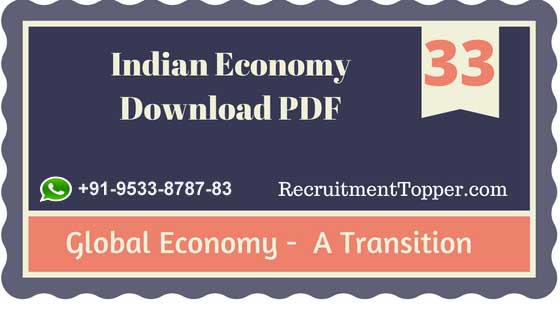Indian Economy | Global Economy – A Transition Download PDF
Contents
Global Transition
The global economy has undergone a sharp transformation in the last two decades. It will be interesting to see evolution of global economy from an economic perspective. It was earlier, dominance of the British Empire with its growing imperialism, colonization and mass-scale exploitation of colonies. Trade flourished adding to wealth of the British Empire but at the cost of the colonies.
The second transition was the wave of breaking free from colonial rule, an era of independence with a large number of countries gaining independence and the beginning point of rebuilding their economies highly protected and regulated.
The third transition was the emergence of US, UK, Germany and Japan as superpowers and the increased polarization of economies referred to as the ‘North-South divide’ (Developed—Developing countries).
A clear dominance and superiority of the North (developed) economies in the global economy. They earned the distinction of being First World countries. Then the demarcation, between the First World and the Third World countries, mosdy developing countries like that of India, China, etc., which only accentuated the divide. This was also referred as the ‘cold war’ period.
The decade of the eighties and nineties had seen the dominance of the QUAD countries comprising of the US, Europe and Japan in terms of global output, trade and investments. The fourth transition was the breakdown of the erstwhile USSR and reforms in China with lesser role of the respective governments and larger role for trade amongst countries.
With China reform process initiated in the seventies and other Asian economies subsequently, the global economy gradually opened up to the Asian economies. This also diffused the polarization and led to evolution of multi-polar trading. The concept of Third World countries, developing countries, or countries looked down upon, changed to that of ‘New and Emerging Economies’ of the global economy. At the same time, it also saw the emergence of the south east economies, as Asian Tigers, rapidly transforming their economies with high rates of growth and sharp increase in income levels. This brought out the importance of trade and open policies and how they can transform economies in a short period.
However, the crisis in these economies was as sudden as their rise, spreading like a contagion which brought in uncertainty and question mark raised on open economies and open policies. Their subsequent revival has somewhat diluted the impact but did set the cautious mode in all these economies. Not with standing the crisis, the last decade has clearly belonged to the ‘emerging economies’ of China, India, S. Korea, Indonesia, etc., emerging as an important players in the global economy in terms of contribution to global output, trade and investment and marks a distinct shifting of axis away from the so-called First World countries.
However, the real turning point, probably the first of its kind ever witnessed in economic history, greater in magnitude than even the great depression of 1929—1933, in terms of the potential fall outs, is the global crisis being witnessed since 2008. Reeling under the shock, the global economy, is beginning yet another transition, of redefinition or even a metamorphosis unheard and unseen ever in the past. It today stands at a crossroad, highly fluid, uncertain, but with a silver lining, of emerging economies coming centre stage but with a rider that they are not growing to their potential and their global competitiveness is decreasing rather than increasing. These economies have “opportunities but with stiff challenges.”

Leave a Reply